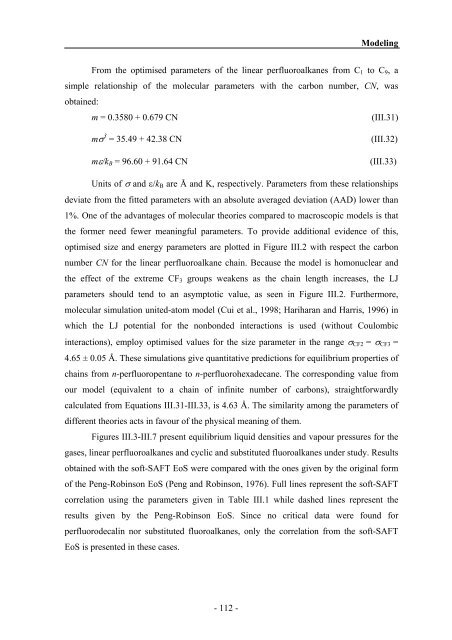n - PATh :.: Process and Product Applied Thermodynamics research ...
n - PATh :.: Process and Product Applied Thermodynamics research ...
n - PATh :.: Process and Product Applied Thermodynamics research ...
Create successful ePaper yourself
Turn your PDF publications into a flip-book with our unique Google optimized e-Paper software.
Modeling<br />
From the optimised parameters of the linear perfluoroalkanes from C1 to C9, a<br />
simple relationship of the molecular parameters with the carbon number, CN, was<br />
obtained:<br />
m = 0.3580 + 0.679 CN (III.31)<br />
mσ 3 = 35.49 + 42.38 CN (III.32)<br />
mε/kB B = 96.60 + 91.64 CN (III.33)<br />
Units of σ <strong>and</strong> ε/kB are Å <strong>and</strong> K, respectively. Parameters from these relationships<br />
deviate from the fitted parameters with an absolute averaged deviation (AAD) lower than<br />
1%. One of the advantages of molecular theories compared to macroscopic models is that<br />
the former need fewer meaningful parameters. To provide additional evidence of this,<br />
optimised size <strong>and</strong> energy parameters are plotted in Figure III.2 with respect the carbon<br />
number CN for the linear perfluoroalkane chain. Because the model is homonuclear <strong>and</strong><br />
the effect of the extreme CF3 groups weakens as the chain length increases, the LJ<br />
parameters should tend to an asymptotic value, as seen in Figure III.2. Furthermore,<br />
molecular simulation united-atom model (Cui et al., 1998; Hariharan <strong>and</strong> Harris, 1996) in<br />
which the LJ potential for the nonbonded interactions is used (without Coulombic<br />
interactions), employ optimised values for the size parameter in the range σCF2 = σCF3 =<br />
4.65 ± 0.05 Å. These simulations give quantitative predictions for equilibrium properties of<br />
chains from n-perfluoropentane to n-perfluorohexadecane. The corresponding value from<br />
our model (equivalent to a chain of infinite number of carbons), straightforwardly<br />
calculated from Equations III.31-III.33, is 4.63 Å. The similarity among the parameters of<br />
different theories acts in favour of the physical meaning of them.<br />
Figures III.3-III.7 present equilibrium liquid densities <strong>and</strong> vapour pressures for the<br />
gases, linear perfluoroalkanes <strong>and</strong> cyclic <strong>and</strong> substituted fluoroalkanes under study. Results<br />
obtained with the soft-SAFT EoS were compared with the ones given by the original form<br />
of the Peng-Robinson EoS (Peng <strong>and</strong> Robinson, 1976). Full lines represent the soft-SAFT<br />
correlation using the parameters given in Table III.1 while dashed lines represent the<br />
results given by the Peng-Robinson EoS. Since no critical data were found for<br />
perfluorodecalin nor substituted fluoroalkanes, only the correlation from the soft-SAFT<br />
EoS is presented in these cases.<br />
- 112 -



